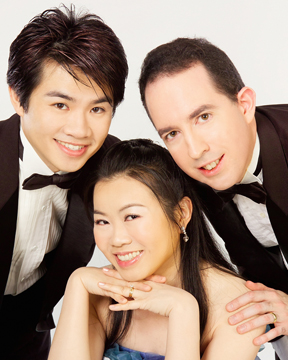The Gemini Piano Trio in Review
The Gemini Piano Trio Hsiu-Hui Wang, piano, Sheng-Tsung Wang, violin, Benjamin Myers, cello Weill Recital Hall at Carnegie Hall, New York, NY October 16, 2010This group is a true family affair: the pianist is the sister of the violinist and the wife of the cellist. No wonder they have achieved such a high level of unanimity and rapport. But of course, though personal kinship can help, it also requires hard work and dedication to forge a fine ensemble and make it sound totally natural.
The Gemini Trio is on the faculty of Maryland’s Goucher College in Baltimore and Howard Community College in Columbia. The members are all active, successful soloists; individually, they hold degrees from the Hartt School of Music, the University of Maryland, Peabody Conservatory, and the New England Conservatory. As a group, they have taken top prizes in many prestigious competitions, performed on several continents, and released two CDs of trios by Brahms, Ravel, Ives, and Shostakovich. This concert marked the Trio’s New York debut.
The program demonstrated the players’ stylistic versatility, featuring masterpieces from three periods: Beethoven’s Trio Op.1 No.1, Shostakovich’s Trio No.2 and Mendelssohn’s Trio No.2. The Beethoven was a model of classical elegance and restraint; phrasing, articulation and dynamics were carefully observed, balance and interplay between the instruments were exemplary. In the Shostakovich, the players allowed themselves more dynamic and emotional abandon without lapsing into excess; the Scherzo was very fast and impetuous but always controlled; the slow movement was heart-breaking. The Mendelssohn was unabashedly romantic: quite free, intense, and ardent. The corner movements were stormy and passionate, the Scherzo was spooky but almost too fast and whispery for human ears to follow, the slow movement was serene and poetic. The phrasing sometimes seemed a bit overdone and lopsided, and there was perhaps an over-abundance of slides. But the playing was always honestly felt and very expressive.
Best of all, the players were concerned only with the music, and used their technical command and tonal variety entirely in its service. They did nothing for effect, never exaggerated, never called attention to themselves, never showed off. The pianist’s pedal technique was remarkable: she seemed to change pedal with every note even in the fastest passages. Moreover, except for the most massive chords, she kept her left foot on the soft pedal, even in her solo passages, so there was no break in the sound quality. As a result, the piano, though wide open, never covered the strings; indeed, it was often too subdued. Altogether, this was a most enjoyable evening of true, unaffected music-making.
Though the printed program requested that the applause be held until after the final movement of each work, the sell-out audience could not restrain itself and showed its enthusiasm after every movement, causing the players to look startled at first, then to smile with amused resignation. To remove the temptation for an outburst after the ghostly Mendelssohn Scherzo, they plunged right into the last movement. After the final ovation, they responded with an encore: a trio arrangement of Elgar’s “Chant d’amour.”

